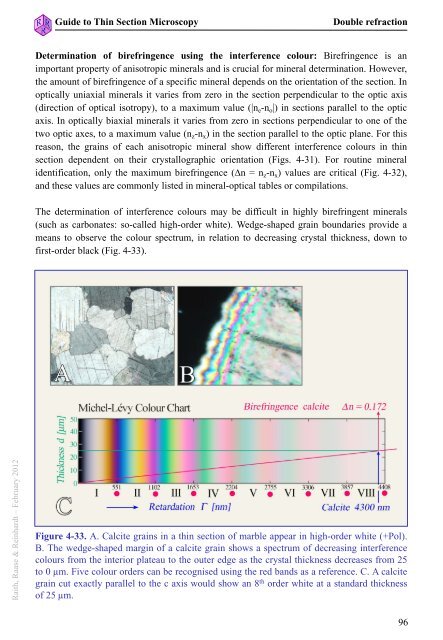guide to thin section microscopy - Mineralogical Society of America
guide to thin section microscopy - Mineralogical Society of America
guide to thin section microscopy - Mineralogical Society of America
Create successful ePaper yourself
Turn your PDF publications into a flip-book with our unique Google optimized e-Paper software.
Guide <strong>to</strong> Thin Section Microscopy<br />
Double refraction<br />
Determination <strong>of</strong> birefringence using the interference colour: Birefringence is an<br />
important property <strong>of</strong> anisotropic minerals and is crucial for mineral determination. However,<br />
the amount <strong>of</strong> birefringence <strong>of</strong> a specific mineral depends on the orientation <strong>of</strong> the <strong>section</strong>. In<br />
optically uniaxial minerals it varies from zero in the <strong>section</strong> perpendicular <strong>to</strong> the optic axis<br />
(direction <strong>of</strong> optical isotropy), <strong>to</strong> a maximum value (|n e -n o |) in <strong>section</strong>s parallel <strong>to</strong> the optic<br />
axis. In optically biaxial minerals it varies from zero in <strong>section</strong>s perpendicular <strong>to</strong> one <strong>of</strong> the<br />
two optic axes, <strong>to</strong> a maximum value (n z -n x ) in the <strong>section</strong> parallel <strong>to</strong> the optic plane. For this<br />
reason, the grains <strong>of</strong> each anisotropic mineral show different interference colours in <strong>thin</strong><br />
<strong>section</strong> dependent on their crystallographic orientation (Figs. 4-31). For routine mineral<br />
identification, only the maximum birefringence (∆n = n z -n x ) values are critical (Fig. 4-32),<br />
and these values are commonly listed in mineral-optical tables or compilations.<br />
The determination <strong>of</strong> interference colours may be difficult in highly birefringent minerals<br />
(such as carbonates: so-called high-order white). Wedge-shaped grain boundaries provide a<br />
means <strong>to</strong> observe the colour spectrum, in relation <strong>to</strong> decreasing crystal thickness, down <strong>to</strong><br />
first-order black (Fig. 4-33).<br />
Raith, Raase & Reinhardt – February 2012<br />
Figure 4-33. A. Calcite grains in a <strong>thin</strong> <strong>section</strong> <strong>of</strong> marble appear in high-order white (+Pol).<br />
B. The wedge-shaped margin <strong>of</strong> a calcite grain shows a spectrum <strong>of</strong> decreasing interference<br />
colours from the interior plateau <strong>to</strong> the outer edge as the crystal thickness decreases from 25<br />
<strong>to</strong> 0 μm. Five colour orders can be recognised using the red bands as a reference. C. A calcite<br />
grain cut exactly parallel <strong>to</strong> the c axis would show an 8 th order white at a standard thickness<br />
<strong>of</strong> 25 μm.<br />
96
















